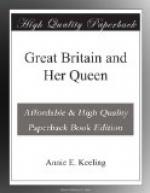[Illustration: Thomas Chalmers.]
There was contemporaneous distress enough and to spare in Great Britain: failures in Lancashire alone to the amount of L16,000,000; failures equally heavy in Birmingham, Glasgow, and other great towns; capital was absorbed by the mad speculations in railway shares; and even Heaven’s gift of an abundant harvest, by at once lowering the price of corn, helped to depress commerce. Many banks stopped payment, and even the Bank of England seemed imperilled, saving itself only by adopting a bold line of policy advised by Government. At the same time, the Chartist movement was gathering the strength which was to expend itself in the futile demonstrations of 1848.
[Illustration: John Henry Newman. From a photograph by Mr. H. J. Whitlock, Birmingham.]
But as if it were not enough for every department of political or commercial life to be so seriously affected, there was now arising within the English National Church itself a singular movement, destined to affect the religious history of the land as powerfully, if not as beneficially, as did the Evangelical revival of the last century; and the National Kirk of Scotland, after long and stern contention on the crucial point of civil control in things spiritual, was ready for that rending in twain from which arose the Free Kirk; while other religious bodies were torn by the same keen spirit of strife, the same revolt against ancient order, as that which was distracting the world of politics. The bitterness of the disruption in Scotland is well-nigh exhausted, though the controversy enlisted at the time all the fervid power of a Chalmers; men honour the memory of the champions, while hoping to see the once sharp differences composed for ever. But the “Catholic Revival,” initiated under the leadership of Newman, Pusey, and Keble, has proved to be no transient disturbance: and no figure has in relation to the Church history of the half-century the same portentous importance as that of John Henry Newman, whose powerful magnetism, as it attracted or repelled, drew men towards Romanism or drove them towards Rationalism, his logical art, made more impressive by the noble eloquence with which he sometimes adorned it, seeming to leave those who came under his spell no choice between the two extremes. When he finally decided on withdrawing himself from the Anglican and giving in his adhesion to the Roman communion, he set an example that has not yet ceased to be imitated, to the incalculable damage of the English Establishment. Happily the massive Nonconformity of the country was hardly touched either by his influence or his example.




